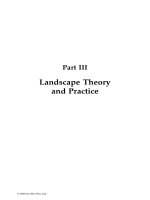Lecture management a pacific rim focus chapter 7 strategic management
Bạn đang xem bản rút gọn của tài liệu. Xem và tải ngay bản đầy đủ của tài liệu tại đây (719.35 KB, 32 trang )
CHAPTER 7
STRATEGIC MANAGEMENT
© 2003 McGraw-Hill Australia Pty Ltd. PowerPoint
1
Lecture summary
• The concept of strategic management
• Role of competitive analysis in strategy formulation
• Formulating corporate level strategy
• Formulating business level strategy
• Formulating functional level strategy
• Strategy implementation
© 2003 McGraw-Hill Australia Pty Ltd. PowerPoint
2
Concept of strategic
management
‘Large-scale action plan for interacting with the environment to
achieve long-term goals.’
© 2003 McGraw-Hill Australia Pty Ltd. PowerPoint
3
Concept of strategic
management
• Strategic management process
• Importance of strategic management
• Levels of strategy
© 2003 McGraw-Hill Australia Pty Ltd. PowerPoint
4
Concept of strategic
management
Strategic management process:
‘Process through which managers formulate and implement
strategies geared to optimising strategic goal achievement,
given available environmental and internal conditions.’
© 2003 McGraw-Hill Australia Pty Ltd. PowerPoint
5
Concept of strategic
management
Strategic management process:
• Strategy formulation
–
Identify mission & goals
– Competitive situation analysis (external & internal)
– Develop/formulate strategies to achieve identified goals
• Strategy implementation
–
Implement plans
– Control/monitor execution of plans
© 2003 McGraw-Hill Australia Pty Ltd. PowerPoint
6
Strategic management process
Environmental
analysis
Formulate
mission &
strategic goals
Conduct SWOT
analysis
Strategy
formulation
Strategy
implementation
Strategic
control
Internal
(organisational)
assessment
© 2003 McGraw-Hill Australia Pty Ltd. PowerPoint
7
Importance of strategic
management
Important because:
• Helps organisations develop a competitive
advantage (significant edge over competition in
dealing with competitive forces).
• Provides a sense of long-term direction for
organisation members.
• Highlights need for innovation.
• Process involves members and fosters
understanding of goals/strategy.
© 2003 McGraw-Hill Australia Pty Ltd. PowerPoint
8
Importance of strategic
management
Competitive advantage
Direction for
the organisation
Supports innovation
Builds manager
commitment
© 2003 McGraw-Hill Australia Pty Ltd. PowerPoint
9
Levels of strategy
Corporate level
Business level
Functional level
© 2003 McGraw-Hill Australia Pty Ltd. PowerPoint
10
Levels of strategy
Corporate level strategy:
‘Type of strategy addressing what businesses the organisation
will operate, how strategies of those businesses will be coordinated to strengthen the organisation’s competitive
position, and how resources will be allocated among
businesses.’
© 2003 McGraw-Hill Australia Pty Ltd. PowerPoint
11
Levels of strategy
Business level strategy:
‘Type of strategy concentrating on the best means of
competing within a particular business while also supporting
corporate level strategy.’
© 2003 McGraw-Hill Australia Pty Ltd. PowerPoint
12
Levels of strategy
Functional level strategy:
‘Type of strategy focussing on action plans for managing a
particular functional area within a business in a way that
supports business level strategy.’
© 2003 McGraw-Hill Australia Pty Ltd. PowerPoint
13
Competitive analysis in strategy
formulation
Before managers devise an effective strategy
for getting a competitive edge, they must
analyse the organisation’s competitive
situation.
This is done through:
• Environmental analysis (external)
• Organisational assessment (internal)
© 2003 McGraw-Hill Australia Pty Ltd. PowerPoint
14
Environmental assessment
Industry &
Market
Analysis
Competitor
Analysis
The
organisation
Economic
Analysis
Political &
Regulatory
Analysis
Social Analysis
Human Resources
Analysis
© 2003 McGraw-Hill Australia Pty Ltd. PowerPoint
15
Competitive analysis in strategy
formulation
SWOT analysis:
Method of analysing an organisation’s competitive situation
involving assessing organisational strengths (S),
weaknesses (W), environmental opportunities (O) and
threats (T).
© 2003 McGraw-Hill Australia Pty Ltd. PowerPoint
16
Competitive analysis in strategy
formulation
Environmental assessment:
Five competitive forces model (Porter):
1.
Rivalry
2.
Bargaining power of customers
3.
Bargaining power of suppliers
4.
Threat of new entrants
5.
Threat of substitute products/services.
© 2003 McGraw-Hill Australia Pty Ltd. PowerPoint
17
Competitive analysis in strategy
formulation
Organisational assessment:
• Value
Do the firm’s resources & capabilities add value by enabling it to exploit
opportunities or neutralise threats?
• Rareness
How many competing firms already possess these valuable resources &
capabilities?
• Imitability
Do firms without a resource or capability face a cost disadvantage?
• Organisation
Is the firm organised to exploit competitive potential of its resources &
capabilities?
© 2003 McGraw-Hill Australia Pty Ltd. PowerPoint
18
Formulating corporate level
strategy
Corporate level strategy is the overall strategy
an organisation follows. Its development
involves selecting a grand strategy and using
portfolio-strategy approaches to determine the
various businesses making up the organisation:
• Grand strategy
• Portfolio-strategy approaches.
© 2003 McGraw-Hill Australia Pty Ltd. PowerPoint
19
Formulating corporate level
strategy
• Growth
• Defensive
Grand strategies:
Concentration
Vertical integration
Diversification
Divestiture
Bankruptcy
Liquidation
• Stability
Harvest
Turnaround
© 2003 McGraw-Hill Australia Pty Ltd. PowerPoint
20
Formulating corporate level
strategy
Portfolio strategies:
Method of analysing an organisation’s mix of businesses in
terms of both individual and collective contributions to
strategic goals.
• BCG growth–share matrix
Compares businesses in an organisation’s portfolio on the
basis of relative market market share and market growth
rate.
• Product–market evaluation matrix
Compares businesses’ strength against product/market lifecycle.
© 2003 McGraw-Hill Australia Pty Ltd. PowerPoint
21
BCG growth-share matrix
Relative competitive position (market share)
Low
Market growth rate
High
Question
marks
Stars
Dogs
Cash cows
© 2003 McGraw-Hill Australia Pty Ltd. PowerPoint
22
Product-market evaluation
matrix
Business unit’s competitive position
Strong
Average
Weak
Product/ Development
Market Growth
Life cycle Shakeout
Growth Maturity
Saturation
Decline
© 2003 McGraw-Hill Australia Pty Ltd. PowerPoint
23
Formulating business level
strategy
• Business level strategy is concerned with how a particular
business competes.
• The best known approach for strategy development is based
on Porter’s research.
© 2003 McGraw-Hill Australia Pty Ltd. PowerPoint
24
Formulating business level
strategy
Generic business strategies:
Porter outlined three generic business level strategies to gain
competitive advantage over other firms operating in the same
industry.
© 2003 McGraw-Hill Australia Pty Ltd. PowerPoint
25









